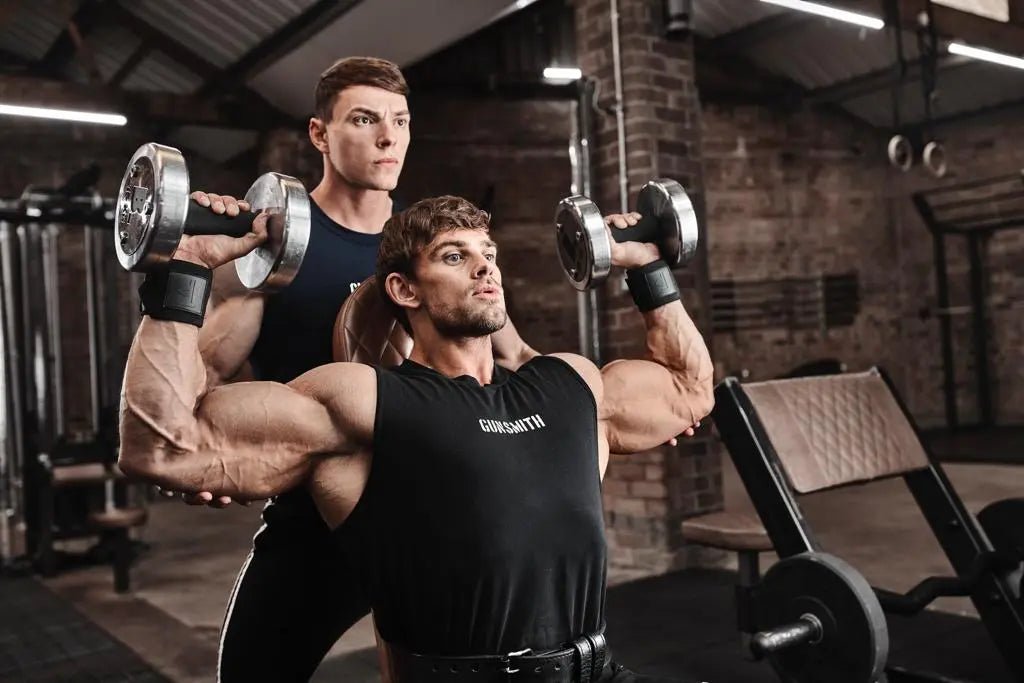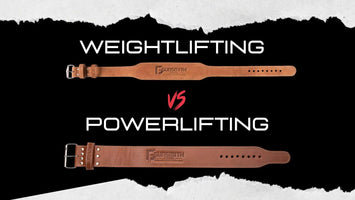
How to Build Bigger Shoulders: Expert Tips for Effective Growth
INTRODUCTION TO BUILDING BIGGER SHOULDERS
Looking to improve your shoulder strength and achieve well-defined deltoids? Incorporating targeted shoulder exercises into your fitness routine can help you achieve those goals. In this article, we'll explore a range of effective shoulder exercises that will boost your shoulder strength, enhance definition, and provide you with a well-rounded upper body workout and build muscle.
Building those round 'Boulder Shoulders' is a goal many fitness enthusiasts strive for, as strong and broad shoulders give the physique an awesome look. The key to achieving this goal of wider shoulders lies in understanding the structure of the shoulder muscles and selecting the right exercises to target each area effectively. With a combination of proper training, technique, and consistency, it is possible to develop the desired shoulder size and strength.
But it's not as easy as that, first we need to understand the anatomy. The shoulder muscles are composed of the deltoid, which itself has three separate sections: the anterior, lateral, and posterior deltoids. These sections are responsible for a variety of arm movements, including pushing, pulling, and lifting in different directions. To achieve balanced and prominent shoulders, it is essential to incorporate a mix exercises in your workout routine that effectively target each of these deltoid heads.
Some of the best exercises for building big shoulders include push-press, military press, bench press, rear delt row, seated dumbbell press, seated barbell press, upright row, Arnold press, rear delt fly, lateral raise, and front raise. By utilising these exercises with the proper form, dedication, and a well-planned workout routine, there's no reason you shouldn't be rocking that roundness in no time.

THE IMPORTANCE OF SHOULDER TRAINING DEVELOPMENT
Developing strong and well-defined shoulders is crucial for achieving balance in the upper body.
Shoulder muscles play a key role in maintaining overall upper body balance. They connect the arms to the torso, allowing for a wide range of motion and stability during physical activities.
Muscle symmetry is another factor that highlights the importance of shoulder development. A balanced physique involves proportionate growth and development of all muscle groups. Well-developed shoulders contribute to the coveted V-taper appearance, making the waist appear smaller while giving an attractive and powerful look.
Developed shoulders enhance performance in sports such as swimming, tennis, and weightlifting, where the shoulder musculature is heavily utilized. By increasing the strength and size of shoulder muscles, you can better execute activities that require upper body movements and power. In addition incorporating them into your routine can improve posture and prevents potential injuries

ANATOMY OF THE BIGGER SHOULDERS
The anatomy of the shoulders plays a vital role in understanding how to develop and strengthen them. The deltoids and trapezius muscles are the main components responsible for shoulder size and strength. We will delve into the specific muscle groups that make up the shoulders and discuss their functions.
ANTERIOR DELTOIDS
The anterior deltoids, commonly known as the front deltoids, are located on the front part of the shoulder. They primarily function in shoulder flexion and medial rotation. This muscle group is important for movements like front raises and overhead presses.
LATERAL DELTOIDS
The lateral deltoids, also referred to as the side or middle deltoids, are positioned on the side of the shoulder. Their primary function involves shoulder abduction, as well as some extension and flexion. These muscle fibers are targeted during exercises such as lateral raises and upright rows.
POSTERIOR DELTOIDS
Located at the back of the shoulder, the posterior deltoids, or rear deltoids, are responsible for shoulder extension and lateral rotation. They play a key role in maintaining stability and strengthening the rotator cuff. Exercises like bent-over rows and reverse flyes target this muscle group effectively.
In addition to the deltoids, the trapezius (traps) muscle contributes to overall shoulder strength and stability. There are three parts to the trapezius: the superior (upper), middle, and inferior (lower) fibers. The primary functions of the traps include elevation, retraction, and depression of the scapula, as well as assisting in rotation and stabilization of the shoulder.
Understanding the anatomy and functions of these shoulder muscles is key for efficiently developing size and strength while minimizing the risk of injury. We'll delve in to cover what exercises cover what parts of the shoulder.

KEY EXERCISES TO BUILD BIGGER SHOULDERS
OVERHEAD PRESS
The overhead press, also known as the military press, is a fundamental exercise for building bigger and stronger shoulders. This pressing movement primarily targets the deltoids and involves the trapezius and other supporting muscles. It can be performed with a barbell or dumbbells. To execute the exercise:
- Stand with feet shoulder-width apart and hold the weight at shoulder level.
- Press the weight overhead, fully extending your arms without arching your back.
- Slowly lower the weight back down to the starting position.
Make sure to keep your back straight and avoid using excessive momentum in the lift.

LATERAL RAISES
Lateral raises are another essential exercise for building shoulder muscle, specifically targeting the middle deltoids. This isolation movement can be performed using dumbbells or resistance bands. Here's how to perform lateral raises:
- Stand with feet shoulder-width apart, holding weights on each side and move dumbbells vertically.
- Raise your arms out to the sides until parallel to the ground, keeping a slight bend in the elbows.
- Lower your arms back down to your sides in a controlled manner.

REAR DELT RAISES
Rear delt raises, also known as reverse flies, focus on the posterior deltoid muscles. This exercise can be done with dumbbells or a cable machine. To perform rear delt raises:
- Hinge at your hips with a slight bend in your knees and a flat back.
- Hold weights with your palms facing each other and elbows slightly bent.
- Raise your arms out to the sides, squeezing the shoulder blades together at the top.
- Lower your arms and bring the dumbbells back down to complete the rep.

FRONT RAISES
Front raises target the anterior deltoid muscles and can be performed with dumbbells, a barbell, or a resistance band to make your shoulders big. To execute front raises for enhancing rear delts:
- Stand with feet shoulder-width apart, holding dumbbell in each hand facing your thighs.
- Raise your arms straight in front of you until parallel to the floor.
- Lower your arms back down to your thighs, maintaining control throughout the movement.

UPRIGHT ROWS
Upright rows work on the lateral deltoids, traps, and rhomboids, helping to build broader shoulders. They can be done with a barbell, dumbbells, or a cable machine. Follow these steps for upright rows:
- Stand with feet shoulder-width apart, gripping the weight with an overhand grip.
- Lift the weight up towards your chin, leading with your elbows and keeping the weight close to your body.
- Lower the weight back down to the starting position in a controlled manner.

ARNOLD PRESS
The Arnold press, named after the legendary bodybuilder Arnold Schwarzenegger, is a powerful exercise that targets all three heads of the deltoids. This compound movement involves rotating the palms during the press, activating additional shoulder muscles and providing a more complete workout. Incorporate Arnold presses into your routine for well-rounded shoulder development.
- Sit down on a bench, preferably on a high incline so your back is supported
- Raise and hold the dumbbells in hand, palms facing towards you, lift the weight in a smooth movement rotating your palms so they face outwards at the end of the exercise
- Lower the weight back down to the starting position by keeping your arms in a controlled manner.
Make sure you use proper form and progressively increase the weight or resistance to stimulate muscle growth in majority of your shoulder.

RECOMMENDED WORKOUTS AND PROGRAMS TO BUILD MUSCLE
SHOULDER WORKOUTS FOR BEGINNERS
For those new to shoulder workouts, it's essential to start with a solid foundation. Concentrate on learning proper form and technique in the following exercises:
- Dumbbell Shoulder Press: This exercise targets the entire shoulder and helps build strength. Start with three sets of 8-12 reps.
- Lateral Raises: Focus on proper form, keeping the movement slow and controlled. Perform three sets of 12-15 reps.
- Face Pulls: This exercise works the rear deltoids and helps prevent imbalances. Perform three sets of 12-15 reps.
As a beginner, aim to complete these exercises twice a week, ensuring you have adequate rest and recovery time between next shoulder workouts.
ADVANCED SHOULDER WORKOUTS
For more experienced individuals, advanced shoulder workouts involve supersets, increased intensity, and heavier weights. Some key exercises include:
- Barbell Overhead Press: This compound exercise targets the entire shoulder and allows for heavier weights. Perform four sets of 6-8 reps.
- Arnold Press: This targets the front and side deltoids and requires good technique. Perform three sets of 8-12 reps.
- Leaning Lateral Raise: This variation of the lateral raise increases range of motion and intensity. Perform three sets of 12-15 reps.
Include these exercises in your training routine to increase shoulder muscle mass and overall definition.
SUPERSET AND HIGH-INTENSITY WORKOUTS FOR WIDER SHOULDERS
Incorporating superset and high-intensity workouts into your shoulder training program can provide maximum results in less time. Some suggested combinations are:
- Superset 1: Dumbbell Shoulder Press (4 sets of 8-10 reps) followed by Face Pulls (4 sets of 12-15 reps) with minimal rest between exercises.
- Superset 2: Lateral Raises (3 sets of 12-15 reps) followed by Incline Y Raises (3 sets of 12-15 reps). Rest for 60 seconds between sets.
- High-Intensity Circuit: Perform each of the following exercises for 30 seconds with 10 seconds of rest between them: Barbell Overhead Press, Lateral Raises, Face Pulls, and Push Press. Complete three rounds with one minute of rest between rounds.
These workouts are designed to challenge your shoulder muscles, incorporating various training techniques for accelerated muscle growth and enhanced strength. Always prioritize proper form and technique to reduce the risk of injury in every shoulder workout.
TECHNIQUES FOR SHOULDER GROWTH
INTENSITY AND VOLUME BALANCE
Finding the right balance between intensity and volume is essential for effective shoulder growth. Intensity refers to the amount of weight or resistance you use, while volume refers to the number of sets and reps for each exercise. Incorporating both high-intensity, low-volume workouts and low-intensity, high-volume workouts can help optimize muscle-building and prevent plateaus.
RANGE OF MOTION
Ensuring a full range of motion throughout each shoulder exercise helps maximize muscle activation and promotes balanced development. Best shoulder exercises such as seated barbell press, lateral raises, and Arnold press can be particularly useful when performed with a controlled, full range of motion. Be mindful of your form to avoid compromising the effectiveness of the movements and decreasing the risk of injury.
ACTIVATION AND ACTIVATION WARM-UP
Before engaging in intense shoulder workouts, it's crucial to perform activation exercises to wake up your shoulder muscles, increase blood flow, and prepare them for the work ahead. A proper warm-up, including shoulder exercises and workouts like band pull-aparts, external rotations, and shoulder circles, can improve muscle activation and prevent potential injuries.
PROGRESSION AND VARIATIONS
Implementing progression and variations in your shoulder exercises for targeting continuous muscle growth. Tracking and progressively increasing the weight or resistance used in exercises helps stimulate muscle growth through increased tension. Additionally, incorporating variations and new exercises, such as push-press, rear delt fly, or supersets, can challenge the muscles from different angles and prevent muscle adaptation, supporting continued growth.

INJURY PREVENTION AND RECOVERY DURING SHOULDER EXERCISE
PROPER FORM IN EXERCISE
To prevent shoulder injuries, it is essential to practice proper form during exercises. Maintaining correct posture and alignment ensures that the muscles and joints are working optimally and reduces injury risk. Key tips for proper form include:
- Keeping your spine in a neutral position
- Engaging your core muscles
- Avoiding excessive shoulder elevation or depression
- Focusing on controlled, deliberate movements
- Gradually increasing the weight or resistance over time, as your strength improves
ROTATOR CUFF STRENGTHENING
If you've ever had a rotator cuff injury, you'll be aware they aren't pleasant, you can be out of action for a while. An effective method for injury prevention and recovery is to strengthen the rotator cuff muscles. These muscles are responsible for stabilizing the shoulder joint and maintaining its proper function. Some popular rotator cuff exercises include:
- Internal rotation: Attach a resistance band to an anchor and hold it in the hand of your exercising arm. Keep your elbow at a 90-degree angle, and slowly rotate your forearm towards your body. Make sure you keep your arms slightly bent to avoid any injury in the socket of the shoulder.
- External rotation: Attach a resistance band to an anchor and hold it in the hand of your exercising arm. Keep your elbow at a 90-degree angle, and slowly rotate your forearm away from your body.
- Scapular retraction: While standing or sitting, pull your shoulder blades together and hold for a few seconds, then relax.
Incorporating these exercises into your workout routine can help protect your shoulder joint from injury and assist in recovery.
ADDRESSING SHOULDER PAIN
Despite taking preventive measures, shoulder pain may still occur. It is crucial to address it promptly and appropriately. Here are some steps to manage shoulder pain:
- Rest: Take a break from activities that aggravate the pain and give your body time to heal.
- Ice: Apply cold packs to the painful area for 15-20 minutes several times a day to reduce swelling and inflammation.
- Compression: Use a compression bandage to provide support and minimize swelling.
- Elevation: Keep the affected shoulder elevated, preferably above heart level, to help reduce swelling.
- Consult a professional: If pain persists or worsens, consult a medical professional for further evaluation and treatment.
By incorporating proper form in exercises, strengthening the rotatory cuff muscles, and addressing shoulder pain when it occurs, you can reduce the risk of shoulder injuries and ensure a healthy recovery.
TOOLS AND EQUIPMENT FOR EFFECTIVE DUMBBELL SHOULDER WORKOUTS FOR MASS
In this section, we will discuss the essential tools and equipment needed for effective workouts to train shoulders. These include dumbbells and barbells, machine shoulder press, and bench variations. Incorporating these tools into your training routine can help you build bigger, stronger shoulders.
DUMBBELLS AND BARBELLS
Dumbbells and barbells are versatile and effective tools for building shoulder muscles. They allow for a wide range of motion and can be used in various exercises. Some of the most popular dumbbell shoulder exercises include:
- Seated or standing shoulder press
- Lateral raises
- Front raises
- Upright rows
Barbells, on the other hand, are ideal for exercises like the push press, which targets multiple muscle groups and allows for heavier lifts. Always use proper form and technique to avoid injury and maximize gains.

MACHINE SHOULDER PRESS
The machine shoulder press is another useful tool if you want big shoulders without any potential risk. This machine provides stability, making it easier for beginners to learn the shoulder press movement. Additionally, it ensures proper form and reduces the risk of injury while training your shoulders. Some of the common shoulder press machines include:
- Seated Machine Shoulder Press
- Smith Machine Shoulder Press
The seated machine shoulder press emphasizes the anterior and lateral deltoids, while the Smith machine shoulder press allows for a controlled movement and more focus on the shoulder muscles. Both machines can help you progressively increase the weight and difficulty of the exercises and give your shoulders much needed strength.
BENCH VARIATIONS
Incorporating different bench variations in your shoulder workout is crucial to target various parts of your shoulder muscles. The three main bench variations are:
- Flat Bench
- Incline Bench
- Decline Bench
The flat bench is ideal for exercises like the seated or lying dumbbell shoulder press, while the incline bench targets the upper portion of the shoulders, especially during an incline dumbbell shoulder press. Lastly, the decline bench can be used for exercises that emphasize the posterior and lower portions of the deltoids.
By using these tools and equipment in your shoulder workouts, you can effectively target all parts of your shoulder muscles, leading to stronger, bigger shoulders. Remember to maintain a neutral, confident, and knowledgeable tone throughout your training and always seek proper guidance from experts to ensure maximum results.
TRAINING ACCESSORIES TO GET BIGGER SHOULDERS
When it comes to building bigger shoulders, incorporating training accessories can make a significant impact on the effectiveness of your workout routine. These additional tools help target specific muscle groups, increase workout intensity, and prevent injuries. Here, we discuss a few essential training accessories that can assist in building impressive shoulders.
Resistance bands: Resistance bands are an excellent addition to any shoulder workout, as they provide constant tension throughout the exercise range of motion. This results in improved muscle activation and growth. Resistance bands can be easily incorporated into various shoulder exercises such as lateral raises, front raises, and face pulls.
Wrist wraps: These can save your wrists when you're moving heavy weights around. Like rotator cuff injuries, if you hurt your wrists, you may need to take some time off.
Weightlifting belts: Useful for exercises such as the military press when you want to keep your core tight. They give that additional support when you need it.
Dumbbells: Dumbbells are versatile pieces of equipment that allow for a wide range of exercises targeting the shoulder muscles. With dumbbells, you can perform exercises such as Arnold press, lateral raises, and bent-over reverse flyes. Dumbbells also enable unilateral training, which helps identify and correct muscle imbalances. You can use heavy or light dumbbells to train your shoulders and get better results.
Barbells: For those looking to develop bigger and stronger shoulders, incorporating barbell exercises is a must. Compound movements such as the military press, push press, and upright row require heavy lifting and target multiple shoulder muscles simultaneously, leading to overall development.
ADDITIONAL FACTORS INFLUENCING SHOULDER HEIGHT AND GROWTH
NUTRITION AND DIET
In order to maximize shoulder growth, it's essential to maintain a balanced diet focused on providing the necessary nutrients and energy for muscle-building. Integrating foods rich in protein, such as lean meats, fish, and legumes, is crucial for muscle repair and development. Additionally, including carbohydrates and healthy fats in your diet will help fuel workouts and aid in recovery.
- Protein: Consume 1.2-1.7 grams per kg of body weight daily.
- Carbohydrates: Aim for 5-7 grams per kg of body weight daily.
- Healthy fats: Make up around 20-35% of daily calorie intake.
A well-rounded diet is essential for overall health and achieving optimal shoulder size.
REST AND SLEEP
Adequate rest and sleep are often overlooked but play a vital role in the growth and development of the shoulder muscles. During sleep, the body undergoes a series of repair and growth processes that are essential for muscle recovery. Aim for 7-9 hours of sleep per night to ensure optimal recovery.
Additionally, allowing rest days between intense shoulder workouts is crucial to prevent overtraining and potential injury. This will not only promote muscle growth but also maintain overall health and well-being.
Elevate your fitness routine and achieve well-defined deltoids by incorporating these effective shoulder exercises. Strengthening your shoulders not only enhances your overall physique but also improves stability and reduces the risk of injuries. Remember to adjust the weights, maintain proper form, and gradually increase the intensity to maximize results. With dedication and consistency, you'll be on your way to impressive shoulder strength and definition with dumbbells and bend exercise.
GIVE YOUR SHOULDERS MUCH NEEDED PUMP
If you want to grow big shoulders with great exercises and workout plans then this blog might have done the job for you. Well, when it comes to shoulders you should not perform any casualty as isolation exercises can take a toll on your efforts to build good physique if not done properly. Also, with these set of exercises you can make your shoulder day a productive one. As of now we have checked the list of the best exercise to grow bigger shoulders. Hope everything is pretty clear to you now!





